Metallica:
Inside-out
Documentary
 INTERNAL
fighting, therapy sessions and tumultuous making of the band's latest
album are headed to the big screen in the documentary "Metallica:
Some Kind of Monster." An unflinching, warts-and-all look at
the band, the film will be part of the 2004 Sundance Film Festival
and will be released next year in theaters.
INTERNAL
fighting, therapy sessions and tumultuous making of the band's latest
album are headed to the big screen in the documentary "Metallica:
Some Kind of Monster." An unflinching, warts-and-all look at
the band, the film will be part of the 2004 Sundance Film Festival
and will be released next year in theaters.
Joe
Berlinger and Bruce Sinofsky directed the film. The duo also directed
the HBO documentaries "Paradise Lost: The Child Murders at Robin
Hood Hills" and "Paradise Lost 2: Revelations," both
of which prominently featured Metallica's music.
A
rough-cut of the "Monster" was shown at private screenings
Thursday (Dec. 11) in New York and Los Angeles. Billboard.com was
among those who got an early look at the film.
Filmed
across more than two years, the film mostly chronicles the band's
ups and downs in making the band's 2003 Elektra release "St.
Anger," and takes its title from one of the album's songs. On
screen, singer/guitarist James Hetfield and drummer Lars Ulrich often
clash, with lead guitarist Kirk Hammett usually acting as peacemaker.
Sessions are interrupted for several months as Hetfield goes into
rehab for alcoholism and other addictions.
 Struggles with artistic
credibility, the Napster controversy and accusations of "selling
out" are presented for all to see. In one scene, manager Cliff
Burnstein pressures the band to record promotional announcements for
an unnamed radio conglomerate's contest. When Burnstein explains that
the company may retaliate by trying to ruin the band's career, Hetfield's
anger and surprise inspires him to write the lyrics, "Wash your
back so you won't stab mine" for the "St. Anger" track
"Sweet Amber."
Struggles with artistic
credibility, the Napster controversy and accusations of "selling
out" are presented for all to see. In one scene, manager Cliff
Burnstein pressures the band to record promotional announcements for
an unnamed radio conglomerate's contest. When Burnstein explains that
the company may retaliate by trying to ruin the band's career, Hetfield's
anger and surprise inspires him to write the lyrics, "Wash your
back so you won't stab mine" for the "St. Anger" track
"Sweet Amber."
Besides
the members of Metallica, other key figures in the film are producer
Bob Rock and therapist Phil Towle, whom Metallica paid $40,000 a month
to help resolve tension in the band. Towle's ubiquitous presence is
notable, as he even spends time in the studio and in songwriting sessions
with Metallica.
During
one therapy session, Ulrich meets with Dave Mustaine, who was fired
from Metallica in 1983 and went on to form Megadeth. Mustaine talks
about the anger and pain he has experienced because of being labeled
as a Metallica reject. The band also deals with the exit of longtime
bassist Jason Newsted, who quit in 2001 and is also featured in the
movie.
Auditions
to replace Newsted see several notable players try out for the band,
including Eric Avery (formerly of Jane's Addiction), ex-Marilyn Manson
guitarist Twiggy Ramirez, Nine Inch Nails' Danny Lohner and Pepper
Keenan of Corrosion Of Conformity fame.
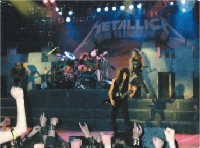 Ulrich
admits Suicidal Tendencies' Robert Trujillo was ultimately chosen
because he was the only one who auditioned who did not struggle to
play Metallica songs. Hetfield adds that Trujillo makes the band play
better and his presence brings a new, more positive energy to the
band that lightens the tone of the film.
Ulrich
admits Suicidal Tendencies' Robert Trujillo was ultimately chosen
because he was the only one who auditioned who did not struggle to
play Metallica songs. Hetfield adds that Trujillo makes the band play
better and his presence brings a new, more positive energy to the
band that lightens the tone of the film.
"Monster"
details that despite problems, undeniable bandmember camaraderie and
underlying mutual respect has allowed Metallica to survive. Honored
with an "MTVicon" tribute and performing to sold out stadiums
at the film's conclusion, shows the band where it is at its best:
playing live. The adoration, undoubtedly crucial to healing some of
the wounds, seems to be the fuel that keeps the band going.
In
addition to this documentary, the inner workings of Metallica will
also be revealed in the group's first official autobiography, tentatively
titled "So What! The Metallibook by Metallica." Random House
subsidiary Broadway Books will publish the book in August 2004.
-
Carla Hay, N.Y. Billboard
Album
Review
AGONTUK
- 2
By
Maher Sayeed
Release
Date: 24th Nov '03. Produced by: G-Series. Sponsor: Pepsi. Album Coordination:
Sumon (Aurthohin)
This Eid, the altermetal fans of Bd got their hands
on one heck of a mixed album named Agontuk-2. This album has been
one of the best mixed albums released by G-Series till date. Here
is a review of the songs in the album:
The album starts off with Aurthohin's 'Juddho', one
of the greatest songs ever made by Aurthohin. Their mighty vocal Sumon
a.k.a. Bassbaba shows off that he is still capable of producing power
vocals although he has reduced singing metal numbers. The guitar &
drums were awesome as usual along with the addition of their new keyboardist,
Shishir. The lyric has a different theme & a mighty song to start
off the album.
The 2nd track, 'Chiley Kothar Shepai' by Artcell will
not sound impressive at first, but the more you listen to it &
understand its depth & if you are a metal fan, you'll surely like
it. Artcell, yet again proves that they are the best metal band in
the country. The song has a melodic ending to it, & indeed is
one of the noteworthy songs of the album.
The next song is perhaps the best song of this album.
Yes, I'm talking about the song, 'Obocheton' by one of the best bands
from the underground scene, Nemesis. The song has a strong influence
of U2 in it. The guitar works is way too good along with awesome vocal,
drums and bass. People who think that this album is not worth their
money, I can assure you that you won't regret after listening to this
song.
If you don't have the song list with you, you'll definitely
think that the next track is by Artcell. In fact, this song, 'Kritodaash'
is by the band Reborn. Their vocal sounds so much familiar to Artcell's
vocal, that even the Artcell fans may get confused. The lyrics of
this song is really catchy & the guitar works & drumming has
geen excellent.
Track 5, 'Odrissho Juddho' is by one of the most senior
bands, Stentorian. Their vocal sounded like Iron Maiden all through
the song & a lot of talent is shown off by their guitarist. All
over, a really good metal track.
'Artonaad' the next track by the young Arbovirus is
a great number & is worth listening to. The guitars sounded pretty
tidy & their vocalist was awesome.
Cryptic Fate comes up next with a completely different
track, 'Prem'. It has a mixture of grunge & newage metal in it,
which is not usual from CF. Everything sounded different apart from
the vocals. Yet it was pretty good & they were able to keep up
their reputation as the pioneers of underground music.
The next track is another extraordinary piece for
which this album is worth buying. Its called 'Shada' by an upcoming
underground band, Breach. The vocal is excellent along with the awesome
guitar works and some exceptional tone selection. Another important
feature of this song is its lyrics which seemed to be out of this
world!!! This song is just too good!
Track 10, 'Shesh' by Kral is really impressive due
to their vocal & drummer, along with an extremely talented guitarist.
Apart from a little uncomfortable vocal, everything
else in the next song, 'Nisshaash' by one of the most senior bands
Dethrow is pretty good. The little recitation in the 2nd verse is
really nice to hear.
The next song, 'Shopno' is by one of the best metal
bands in the underground scene, dNA. This time, Shishir shows his
guts with the guitar. His works are well supported by the bassist,
vocal & drummer.
Then, Black packs up the album with a perfect alternative
number called 'Shokarto Upokul'. Their vocal, Jon, starts off in a
soothing manner & spices up the chorus with his trademark singing
style. After releasing their 2nd album just a few days back, they
yet again prove that they are the best in the country when it comes
to alternative music.
The last number is a bonus track, 'Arrival' an instrumental
by Kamal of Warfaze. This has been a masterpiece with Sumon of Aurthohin
in bass, Shaju of Artcell in drums & Mithu in keys. An excellent
way to end the album
Summing
up, this is one of the greatest mixed albums ever. Special thanks
to Sumon Bhai and G-Series for making this Eid a memorable one for
all the altermetal fans and making an outstanding album.
Prince
of Persia: The Sands of Time
Gamespot
Rating: 8.9 in 10. Publisher\Developer: Ubisoft. Genre: Action Adventure.
Release Date: December 2. Difficulty: Easy. Learning Curve: From 0
to 15 Minutes. Stability: Stable. Requirements: 256 MB RAM, 1400 MB
disk space.
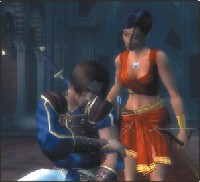 No
previous experience with the Prince of Persia series is required to
enjoy Prince of Persia: The Sands of Time. In fact, virtually nothing
will bar you from being impressed by this extremely well-put-together
action adventure game from the studio that brought you Splinter Cell
and Rainbow Six 3. In stark contrast to Ubisoft Montreal's previous
offerings, Prince of Persia is surprisingly easy, despite the incredible
acts of skill and daring that the game's main character will routinely
perform during the course of the game. As a result, this original,
visually stunning game can be highly recommended to just about anyone.
The new PC port, whose release trailed a few weeks behind its console
counterparts, is just about as impressive as the others, overall.
It's a fairly short game, and it's missing the console versions' bonus
features, but it's truly excellent for as long as it lasts.
No
previous experience with the Prince of Persia series is required to
enjoy Prince of Persia: The Sands of Time. In fact, virtually nothing
will bar you from being impressed by this extremely well-put-together
action adventure game from the studio that brought you Splinter Cell
and Rainbow Six 3. In stark contrast to Ubisoft Montreal's previous
offerings, Prince of Persia is surprisingly easy, despite the incredible
acts of skill and daring that the game's main character will routinely
perform during the course of the game. As a result, this original,
visually stunning game can be highly recommended to just about anyone.
The new PC port, whose release trailed a few weeks behind its console
counterparts, is just about as impressive as the others, overall.
It's a fairly short game, and it's missing the console versions' bonus
features, but it's truly excellent for as long as it lasts.
Prince of Persia:
The Sands of Time takes place in a mystical Middle Eastern setting,
all bathed in soft, warm light and looking like something straight
out of a storybook. You play as a young prince who possesses exceptional
athletic and acrobatic skill. Early on in the game, the prince steals
the dagger of time, a treasure from a rival nation, as a token for
his father the king. When a traitorous vizier compels the prince to
use the dagger to unlock another treasure, a huge hourglass, everything
goes wrong. The sands from the hourglass blow forth, enveloping the
kingdom and turning its guardsmen and citizens into, for lack of a
better way to describe it, "sand zombies." The prince, the
vizier, and a young woman named Farah are among the only survivors.
In the prince's efforts to undo his mistake, he'll join forces with
Farah, seek out the hourglass, and confront the vizier. The game's
story takes a backseat during most of the game, but it is bookended
nicely and is framed as the prince's own retrospection. So, for instance,
should the prince fall and die at a certain point during the game,
you'll hear him say, as narrator, something like, "No, that's
not how it happened." Not only is this an interesting technique,
but it compels you to keep pressing on.
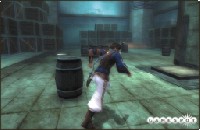 The
prince's new dagger of time has other uses besides causing calamity.
It's the key to defeating the evil spread throughout the palace, and
it also makes the prince virtually immortal. In most cases, should
the prince fall to his death or be slain by a sand creature or a trap,
with his last breath, he may use the dagger to "rewind"
the course of time to a point prior to the unfortunate incident that
would have ended his life. Each time you use this ability, it costs
a "sand tank," which you earn a greater quantity of as you
get farther into the game, and which you restore by defeating sand
creatures. In practice, you won't often run out of sand tanks, but
even if you do, you'll restart the prince's story from a recent location.
The
prince's new dagger of time has other uses besides causing calamity.
It's the key to defeating the evil spread throughout the palace, and
it also makes the prince virtually immortal. In most cases, should
the prince fall to his death or be slain by a sand creature or a trap,
with his last breath, he may use the dagger to "rewind"
the course of time to a point prior to the unfortunate incident that
would have ended his life. Each time you use this ability, it costs
a "sand tank," which you earn a greater quantity of as you
get farther into the game, and which you restore by defeating sand
creatures. In practice, you won't often run out of sand tanks, but
even if you do, you'll restart the prince's story from a recent location.
A highly responsive,
very forgiving control scheme further ensures that at no point during
Prince of Persia: The Sands of Time will you get particularly stuck,
if at all. Though other action adventure games involving a lot of
death-defying leaps and other such bravery tend to force the player
to perfectly time his or her maneuvers and often force him or her
to wrestle with issues concerning the controls or camera perspective,
Prince of Persia is set up in such a way that it's remarkably simple
to pull off all of the prince's spectacular moves. The default PC
controls are a mouse-and-keyboard combination, similar to what you'd
use with a typical first-person shooter. They work well, though not
quite as well as the console versions' gamepad controls. On consoles,
it's a bit easier to move in the direction of your foes, as the camera
changes angles and the analog control lets you move with more precision.
However, the default PC controls ultimately aren't detrimental to
the game.
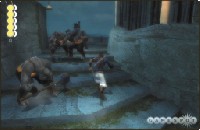 Despite
the convincing look of its huge environments, the game is completely
linear, and the prince's course tends to be very clear. Doors will
slam shut behind him, forcing him to press onward, and each time you
enter a new area, you'll see a quick fly-through showing where it
is you're trying to go and what it is that stands between you and
that goal. Additionally, at each of the game's frequent save points,
you'll see a "vision" of what lies ahead--a quick sepia-toned
montage of the trials and tribulations to come in the next area.
Despite
the convincing look of its huge environments, the game is completely
linear, and the prince's course tends to be very clear. Doors will
slam shut behind him, forcing him to press onward, and each time you
enter a new area, you'll see a quick fly-through showing where it
is you're trying to go and what it is that stands between you and
that goal. Additionally, at each of the game's frequent save points,
you'll see a "vision" of what lies ahead--a quick sepia-toned
montage of the trials and tribulations to come in the next area.
The prince has
a great variety of really impressive moves at his disposal. Like a
Mid-Eastern Spider-Man, he can defy gravity to a certain extent, by
triangle-jumping from wall to wall, running horizontally along vertical
surfaces, balancing on narrow ledges, swinging wildly from ropes or
horizontal bars, jumping from pillar to pillar, and more. He's truly
the most acrobatic character in a game, to date, and executing his
moves is simple and even intuitive. The prince can't be made to accidentally
fall; he'll automatically grab the ledge if you walk him off of one,
and you can hang on indefinitely. A separate key is used for pulling
yourself up as opposed to letting go, so there's no worry of accidentally
dropping even when you seem to be hanging on for dear life.
The gameplay boils
down to two things: observation and timing. First you must figure
out where it is you're trying to go, which tends to be evident from
the area fly-throughs, the "visions," and the occasional
markings seen in the levels that point out switches to be flipped
or buttons to be pressed. Then you must get there by running along
walls, avoiding traps, leaping across chasms, and more. The timing
isn't difficult--there's noticeable room for error--and hitting the
"jump" key at around the right time, either to roll underneath
a trap or to jump at more or less the right moment, will usually do
the trick.
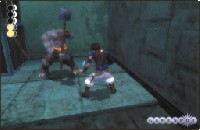 The
coolest thing about the prince's repertoire of moves is how quickly
he can link them together and how nimbly he moves about, in general.
The interactions between the prince and the environment are extremely
convincing and really must be seen to be fully appreciated. Great,
little details are everywhere. If you're standing knee-deep in water
and try to run up a wall, you'll see (and hear) the prince's wet feet
slip as he fails the move. If you leap straight into a wall, you'll
see the prince push himself off and fall back down. Despite his superhuman
balance and agility, the prince somehow comes off looking incredibly
lifelike and realistic, which makes the gameplay seem all the more
approachable. All the prince's moves seem logical in the context of
the game, and even early on you'll learn how to tie all these techniques
together. For instance, you'll have a chance to launch yourself to
the other side of a wall while running across it at early stages of
the game. Of further note, special commendation goes to the prince
for being the fastest ladder-climber in the history of games. It's
a pleasure to just maneuver this character around, which is good,
since that's mostly what you'll be doing.
The
coolest thing about the prince's repertoire of moves is how quickly
he can link them together and how nimbly he moves about, in general.
The interactions between the prince and the environment are extremely
convincing and really must be seen to be fully appreciated. Great,
little details are everywhere. If you're standing knee-deep in water
and try to run up a wall, you'll see (and hear) the prince's wet feet
slip as he fails the move. If you leap straight into a wall, you'll
see the prince push himself off and fall back down. Despite his superhuman
balance and agility, the prince somehow comes off looking incredibly
lifelike and realistic, which makes the gameplay seem all the more
approachable. All the prince's moves seem logical in the context of
the game, and even early on you'll learn how to tie all these techniques
together. For instance, you'll have a chance to launch yourself to
the other side of a wall while running across it at early stages of
the game. Of further note, special commendation goes to the prince
for being the fastest ladder-climber in the history of games. It's
a pleasure to just maneuver this character around, which is good,
since that's mostly what you'll be doing.
